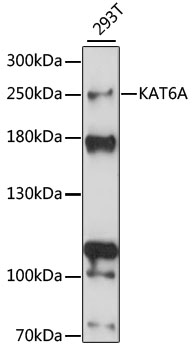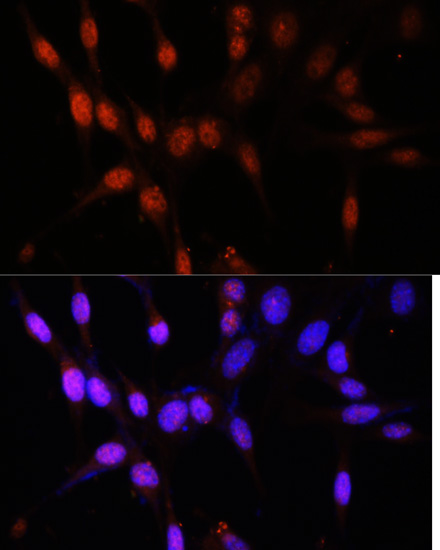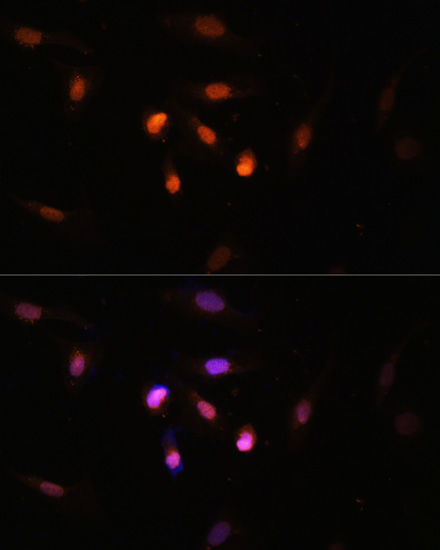Epigenetics & Nuclear Signaling Antibodies 2
Anti-KAT6A Antibody (CAB15006)
- SKU:
- CAB15006
- Product Type:
- Antibody
- Reactivity:
- Human
- Reactivity:
- Mouse
- Reactivity:
- Rat
- Host Species:
- Rabbit
- Isotype:
- IgG
- Antibody Type:
- Polyclonal Antibody
- Research Area:
- Epigenetics and Nuclear Signaling
Description
| Antibody Name: | Anti-KAT6A Antibody |
| Antibody SKU: | CAB15006 |
| Antibody Size: | 20uL, 50uL, 100uL |
| Application: | WB IHC IF |
| Reactivity: | Human, Mouse, Rat |
| Host Species: | Rabbit |
| Immunogen: | Recombinant fusion protein containing a sequence corresponding to amino acids 800-1000 of human KAT6A (NP_001092883.1). |
| Application: | WB IHC IF |
| Recommended Dilution: | WB 1:500 - 1:2000 IHC 1:50 - 1:200 IF 1:50 - 1:200 |
| Reactivity: | Human, Mouse, Rat |
| Positive Samples: | 293T |
| Immunogen: | Recombinant fusion protein containing a sequence corresponding to amino acids 800-1000 of human KAT6A (NP_001092883.1). |
| Purification Method: | Affinity purification |
| Storage Buffer: | Store at -20'C. Avoid freeze / thaw cycles. Buffer: PBS with 0.02% sodium azide, 50% glycerol, pH7.3. |
| Isotype: | IgG |
| Sequence: | EEPQ CQER ELEI SVGK SVSH ENKE QDSY SVES EKKP EVMA PVSS TRLS KQVL PHDS LPAN SQPS RRGR WGRK NRKT QERF GDKD SKLL LEET SSAP QEQY GECG EKSE ATQE QYTE SEEQ LVAS EEQP SQDG KPDL PKRR LSEG VEPW RGQL KKSP EALK CRLT EGSE RLPR RYSE GDRA VLRG FSES SEEE EEPE SPRS S |
| Gene ID: | 7994 |
| Uniprot: | Q92794 |
| Cellular Location: | Nucleus, PML body, nucleolus, nucleoplasm |
| Calculated MW: | 225kDa |
| Observed MW: | 250kDa |
| Synonyms: | KAT6A, MOZ, MRD32, MYST-3, MYST3, RUNXBP2, ZC2HC6A, ZNF220 |
| Background: | This gene encodes a member of the MOZ, YBFR2, SAS2, TIP60 family of histone acetyltransferases. The protein is composed of a nuclear localization domain, a double C2H2 zinc finger domain that binds to acetylated histone tails, a histone acetyl-transferase domain, a glutamate/aspartate-rich region, and a serine- and methionine-rich transactivation domain. It is part of a complex that acetylates lysine-9 residues in histone 3, and in addition, it acts as a co-activator for several transcription factors. Allelic variants of this gene are associated with autosomal dominant mental retardation-32. Alternative splicing results in multiple transcript variants. |
| UniProt Protein Function: | MYST3: Histone acetyltransferase that acetylates lysine residues in histone H3 and histone H4 (in vitro). Component of the MOZ/MORF complex which has a histone H3 acetyltransferase activity. May act as a transcriptional coactivator for RUNX1 and RUNX2. Chromosomal aberrations involving KAT6A may be a cause of acute myeloid leukemias. Translocation t(8;16)(p11;p13) with CREBBP; translocation t(8;22)(p11;q13) with EP300. KAT6A- CREBBP may induce leukemia by inhibiting RUNX1-mediated transcription. Inversion inv(8)(p11;q13) generates the KAT6A-NCOA2 oncogene, which consists of the N-terminal part of KAT6A and the C-terminal part of NCOA2/TIF2. KAT6A-NCOA2 binds to CREBBP and disrupts its function in transcription activation. A chromosomal aberration involving KAT6A is a cause of therapy-related myelodysplastic syndrome. Translocation t(2;8)(p23;p11.2) with ASXL2 generates a KAT6A-ASXL2 fusion protein. Belongs to the MYST (SAS/MOZ) family. |
| UniProt Protein Details: | Protein type:Acetyltransferase; EC 2.3.1.48; Oncoprotein; Nucleolus Chromosomal Location of Human Ortholog: 8p11 Cellular Component: Golgi apparatus; nucleoplasm; nucleus; PML body Molecular Function:acetyltransferase activity; DNA binding; histone acetyltransferase activity; protein binding; transcription coactivator activity; transcription factor binding; zinc ion binding Biological Process: DNA packaging; histone acetylation; myeloid cell differentiation; negative regulation of transcription, DNA-dependent; positive regulation of transcription, DNA-dependent; protein amino acid acetylation Disease: Mental Retardation, Autosomal Dominant 32 |
| NCBI Summary: | This gene encodes a member of the MOZ, YBFR2, SAS2, TIP60 family of histone acetyltransferases. The protein is composed of a nuclear localization domain, a double C2H2 zinc finger domain that binds to acetylated histone tails, a histone acetyl-transferase domain, a glutamate/aspartate-rich region, and a serine- and methionine-rich transactivation domain. It is part of a complex that acetylates lysine-9 residues in histone 3, and in addition, it acts as a co-activator for several transcription factors. Allelic variants of this gene are associated with autosomal dominant mental retardation-32. Alternative splicing results in multiple transcript variants. [provided by RefSeq, Apr 2015] |
| UniProt Code: | Q92794 |
| NCBI GenInfo Identifier: | 215274095 |
| NCBI Gene ID: | 7994 |
| NCBI Accession: | Q92794.2 |
| UniProt Secondary Accession: | Q92794,Q76L81, |
| UniProt Related Accession: | Q92794 |
| Molecular Weight: | 225,028 Da |
| NCBI Full Name: | Histone acetyltransferase KAT6A |
| NCBI Synonym Full Names: | lysine acetyltransferase 6A |
| NCBI Official Symbol: | KAT6A |
| NCBI Official Synonym Symbols: | MOZ; MRD32; MYST3; MYST-3; ZNF220; RUNXBP2; ZC2HC6A |
| NCBI Protein Information: | histone acetyltransferase KAT6A |
| UniProt Protein Name: | Histone acetyltransferase KAT6A |
| UniProt Synonym Protein Names: | MOZ, YBF2/SAS3, SAS2 and TIP60 protein 3; MYST-3; Monocytic leukemia zinc finger protein; Runt-related transcription factor-binding protein 2; Zinc finger protein 220 |
| Protein Family: | Histone acetyltransferase |
| UniProt Gene Name: | KAT6A |
| UniProt Entry Name: | KAT6A_HUMAN |
View AllClose









